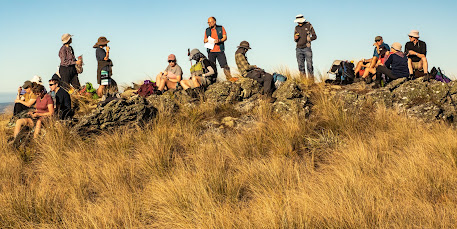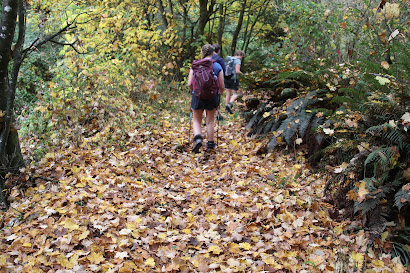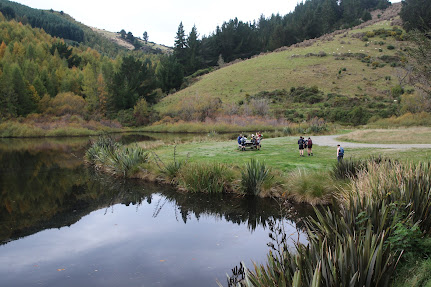Thankfully as we got closer to our destination the fog was burning off and the landscape around us was opening up to reveal clear blue skies and miles upon miles of tussock on the surrounding hills. The landscape was not the only thing changing however - the road changed from a highway to a narrow windy tarseal road to gravel to a slightly less maintained gravel road to a farm track with hollows big enough to swallow a car. We were not going to let this stop us and after passing through some farm gates we soon found ourselves parking in a nondescript paddock.
Instead of the usual pre-trip briefing, our leader, Antony Hamel, gave us a crash course in flag semaphore. We were relieved there were no bulls in the paddock, as surely our eager flag waving would have sent the wrong message and we would have accidentally recreated the Pamplona Bull Run. Once our leader was satisfied we were well trained and equipped to use our flags to communicate vital information to our fellow trampers - think “my hovercraft is full of eels” - we set off. After battling through near head-high tussock to reach the DOC sign that marks the beginning of the reserve, it soon became apparent that the theme of the day was going to be long tussock with no track. Well, everyone else was grumbling about no track… being at the back of a line of 19 people I couldn’t work out what the problem was! One thing about tussock walking is it can be incredibly uneven and slippery, especially as the large clumps of grass were well above waist high in places which meant seeing exactly where you were putting your feet was impossible! Being so focused on staying upright, we were shocked when we stopped for a breather and turned around to see how quickly we had gained height without even realising it. The view was just opening up in front of us, with Lake Mahinerangi as the centre piece, sparkling in the morning sun. Turning our backs to the view, we continued plodding upwards, knowing the view would only get better the higher we climbed. The group was starting to spread out now and were no longer walking in a line, which meant I was now starting to understand what they meant when they said there was no track - there was NO track! It was very much a ‘follow the path of least resistance’ endeavour, which thankfully was straight forward enough and I soon found myself joining the others for a much needed morning tea break. On a previous trip, another member commented to me “you don’t get a lot of time to eat on these OTMC trips!”, which is true as I barely had time to sit down and open my lunch box before we were packing up again! Grabbing a handful of crackers to nibble on as we walked, I hurriedly followed as I had learnt my lesson to stick with the group so I could follow in their footsteps rather than find my own way through the tussock.We were now heading to a group of large rock tors on the skyline, and although the climb was steady, it didn’t prove too difficult. Our only obstacle was a band of spaniards and more than one of us fell victim to the prickly plants hiding beneath the tussock. We were so engaged in our various conversations that in what felt like no time at all, we had arrived at the base of a ginormous rock. Turning around to face the view - wow! The golden tussock contrasted perfectly with the deep blue sky, a true representation of Otago’s blue and gold colours. In front of us were miles and miles of rolling hills, from the tussock covered hills of the Te Papanui Conservation Park to the dark green native bush of Manguatua in the distance.Lake Mahinerangi sat proudly in the middle, all of us marveling at how much larger it was than we had thought driving past earlier this morning. Lunch was had with all 19 of us perched on a rock - yes that's how big the rocks were! As it was the day after the Coronation, it was only right that we toasted the King, as well as each of the past 12 trips to the area. Finally, our flags came to good use!Those who had been to the area before were in awe of the weather conditions - not a breath of wind and close to 20°c. This is apparently very unusual for the area, and unsurprisingly no one seemed super keen to rush back down the hill. After lunch, we spent some time exploring the area. Some chose to keep heading up to the highest point while the majority of us decided to explore the rock tors. After having a good look around, and taking the classic Instagram picture - a person on a rock with a gorgeous view behind them - we sadly had to begin our descent. Somehow the descent proved much trickier than the ascent as any semblance we had of a track on the way up was nowhere to be found! One rock stood out in particular - Walrus Rock. I’m not quite sure why it’s named that as it didn’t look like a walrus to me but it certainly is magnificent. It was a large arch-shaped rock, with a small tarn in the middle of it. The day was so calm and still, which meant the reflections in the tarn were simply stunning. We all took turns getting creative and taking photos of one another through the arch while some of the more adventurous among us climbed up on top of the rock.After many tumbles, cries of pain from unexpected spaniard attacks and nearly dislocating hips from the long strides needed to navigate over the tussock, we arrived at the bottom of the hill - Nardoo had been Nardone!
by Jade Pettinger























































